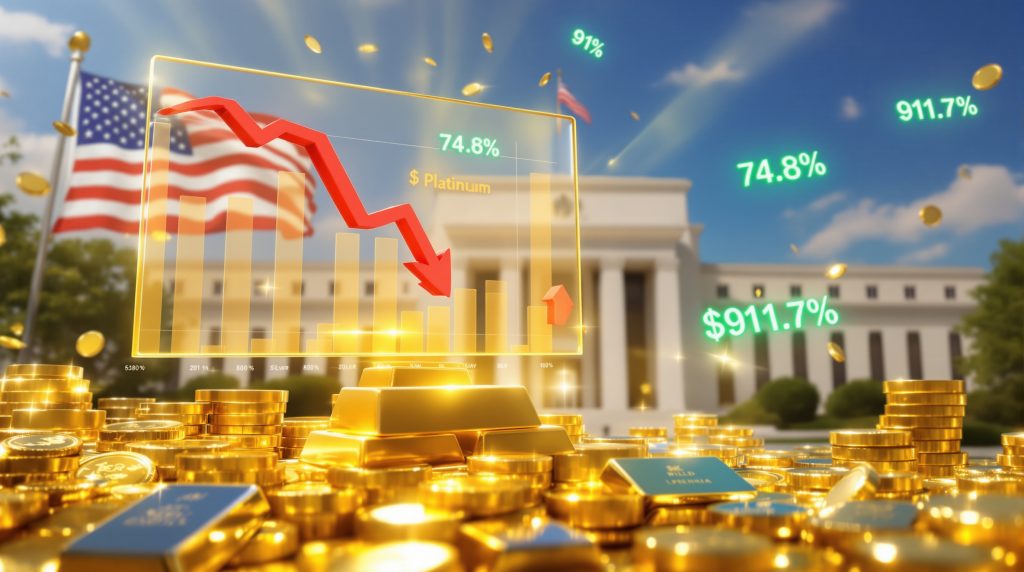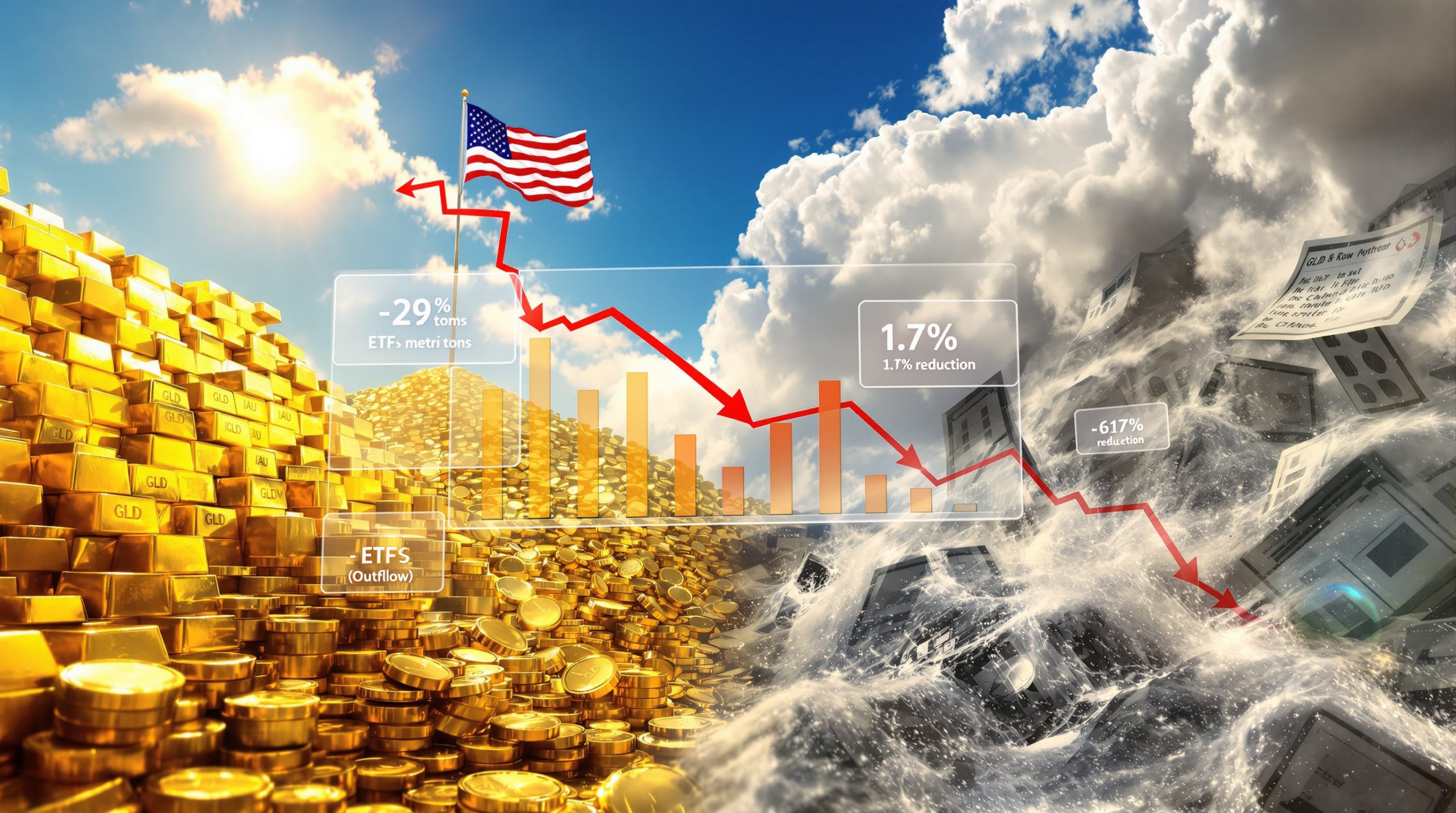Understanding the Federal Reserve's Impact on Precious Metal Markets
The precious metals market demonstrates remarkable sensitivity to monetary policy shifts, with recent Federal Reserve communications creating substantial volatility across gold trading platforms. Market participants witnessed this dynamic firsthand when gold slips as Fed rate caution boosts dollar, as Chair Jerome Powell's cautious stance regarding future rate cuts triggered immediate price adjustments, despite the central bank implementing its second quarter-point reduction of 2025.
Current Federal Reserve policy maintains the benchmark rate within a 3.75%-4.00% target range following two separate 25-basis-point cuts implemented throughout 2025. However, the trajectory of future monetary policy has become increasingly uncertain, with market probability assessments showing dramatic shifts in expectations for additional accommodation.
Key Federal Reserve Policy Metrics:
- Current benchmark rate: 3.75%-4.00% target range
- Year-to-date rate reductions: 50 basis points total
- December cut probability decline: -16.3 percentage points
- Market sentiment shift: From aggressive easing expectations to cautious positioning
Tim Waterer, Chief Market Analyst at KCM Trade, emphasised that the Federal Reserve Chair adopted a notably hawkish positioning during recent policy communications, creating headwinds for gold markets. The analyst noted that December rate cut prospects have transformed from a near-certainty into a significantly more uncertain proposition, strengthening the dollar while complicating gold's investment appeal from a yield comparison standpoint.
The relationship between Fed policy and non-yielding assets operates through opportunity cost calculations. Gold, as a commodity that generates no interest or dividend income, becomes less attractive when risk-free alternatives like Treasury securities offer higher yields. This dynamic explains why hawkish Fed communications can suppress precious metals demand even when actual rate cuts occur.
Dollar Strength Creates Currency Conversion Headwinds
The inverse relationship between dollar performance and precious metals pricing continues to demonstrate its fundamental importance in global commodity markets. Recent dollar index movements to three-month highs against major rival currencies have created immediate pressure on gold valuations, illustrating the mechanical relationship between currency strength and international purchasing power.
Current Dollar-Gold Market Dynamics:
- Dollar index position: Near three-month highs
- Spot gold daily movement: Down 0.4% to $4,005.54 per ounce
- December futures pricing: Steady at $4,018.10 per ounce
- International buyer impact: Reduced purchasing power for non-USD holders
When the U.S. dollar appreciates against major trading currencies, gold becomes proportionally more expensive for international buyers conducting transactions in euros, sterling, yen, or yuan. This currency conversion effect operates independently of underlying gold supply and demand fundamentals, creating price pressure through reduced accessibility for global market participants.
The mechanics of this relationship extend beyond simple conversion mathematics. Central banks, institutional investors, and retail buyers in foreign markets must allocate increasing amounts of their domestic currency to purchase the same physical gold quantities. This dynamic often triggers buying delays, order size reductions, or complete demand postponement until currency relationships stabilise.
Regional Currency Impact Assessment
Furthermore, the gold prices analysis reveals distinct patterns across different currency zones. The eurozone experiences increased conversion costs leading to reduced institutional demand, whilst UK sterling holders face higher effective prices resulting in delayed retail purchases.
Japanese yen weakness creates currency headwinds that prompt central bank position adjustments. In addition, Chinese yuan pressure affects trade-weighted calculations, leading to modified accumulation patterns among domestic investors.
Federal Reserve Rate Decisions Signal Policy Direction Changes
The Federal Reserve's October 29, 2025 rate cut of 25 basis points represented the second reduction implemented during the current calendar year, bringing the total easing to 50 basis points. However, market participants focused intensively on the accompanying commentary and forward guidance rather than the immediate policy action itself.
Chair Jerome Powell's remarks following the rate decision triggered substantial reassessment of December policy expectations. Market probability assessments, tracked through CME Group's FedWatch tool, showed dramatic shifts in expectations for additional accommodation at the final 2025 policy meeting.
December Rate Cut Probability Evolution:
- Previous week assessment: 91.1% probability of 25-basis-point reduction
- Current market pricing: 74.8% probability
- Probability decline: 16.3 percentage points
- Market interpretation: Increased uncertainty regarding Fed accommodation
This probability shift demonstrates the outsized importance of Federal Reserve communication relative to actual policy implementation. The 25-basis-point cut was largely anticipated by market participants, but Powell's cautious tone regarding future moves created unexpected uncertainty about the central bank's commitment to continued easing.
The interest rate environment affects gold through multiple interconnected channels. Higher rates increase opportunity costs for holding non-yielding assets, strengthen the dollar through yield differentials, and alter portfolio allocation decisions among institutional investors. Real interest rates, calculated as nominal rates minus inflation expectations, provide particularly important signals for gold demand as an inflation hedge.
Forward Rate Expectations Impact Analysis
Market participants now assign nearly equal probability to rate cut versus no-change scenarios for December, representing a fundamental shift from previous expectations of continued accommodation.
Consequently, the gold price forecast must account for this shifting monetary policy landscape and its implications for precious metals demand.
Geopolitical Developments Reduce Safe-Haven Demand Premium
Recent diplomatic developments between the United States and China have contributed to reduced geopolitical risk perceptions in financial markets, affecting gold's traditional role as a crisis hedge asset. President Trump announced agreements with Chinese President Xi Jinping addressing multiple bilateral trade and security issues that had previously created market uncertainty.
Key Bilateral Agreement Components:
- Tariff reduction commitments on Chinese imports
- Enhanced cooperation on illicit fentanyl trade enforcement
- Resumption of U.S. agricultural exports to China
- Continued rare earth mineral export flows
These diplomatic agreements address several sources of previous market anxiety, including trade war escalation risks, critical supply chain disruptions, and bilateral economic relationship deterioration. When perceived geopolitical risks decline, investors typically reduce allocations to traditional safe-haven assets like precious metals, shifting capital toward higher-yielding or growth-oriented investments.
The safe-haven demand mechanism operates independently of macroeconomic fundamentals or monetary policy considerations. During periods of elevated uncertainty, institutional and retail investors systematically increase precious metals exposure as portfolio insurance against broader market disruptions. Conversely, diplomatic progress and reduced tensions can trigger meaningful outflows from gold positions.
However, market participants should recognise that geopolitical risk reduction represents just one factor influencing precious metals demand. Currency dynamics, interest rate expectations, and physical market supply-demand balances continue operating simultaneously with geopolitical gold drivers considerations.
Asian Market Activity Reflects Price-Sensitive Regional Demand
Regional precious metals markets in Asia demonstrated distinct response patterns to recent price movements, with Indian gold trading showing particular sensitivity to international price fluctuations. For the first time in seven weeks, Indian gold markets recorded discount pricing relative to international benchmarks, indicating that recent price levels had constrained regional demand.
Asian Market Response Indicators:
- Indian gold discount: First occurrence in seven weeks
- Regional hub activity: Increased trading during price pullbacks
- Price sensitivity: Renewed buying interest following corrections
- Supply-demand balance: Temporary abundance relative to local demand
The emergence of discount pricing in Indian markets signals important demand dynamics within the world's second-largest gold consuming region. When gold trades at discounts in major regional hubs, it typically indicates either temporary supply abundance or subdued local demand relative to international price levels.
Indian gold market premiums and discounts operate as real-time indicators of regional supply-demand balance. Premium pricing suggests strong local demand exceeding available supply, while discount conditions indicate the opposite dynamic. The seven-week premium period preceding the current discount suggests that elevated international prices had gradually reduced Indian buyer participation.
Regional Market Structure Analysis
Asian precious metals markets operate with distinct characteristics from primary trading centres in London and New York. Local factors including import duties, currency exchange rates, refining capacity, and cultural demand patterns create premium and discount variations that provide valuable market intelligence.
Furthermore, the gold market performance across different regions demonstrates how local conditions can significantly influence pricing dynamics beyond global fundamentals.
Factors Influencing Regional Pricing:
- Import tariff structures affecting landed costs
- Local currency strength relative to the U.S. dollar
- Physical refining and processing capacity
- Seasonal cultural and religious demand cycles
- Regional central bank accumulation policies
Technical Analysis Reveals Critical Price Levels for Traders
Current gold price action around the $4,005 level provides important technical reference points for market participants monitoring potential direction changes. Spot gold's decline to $4,005.54 per ounce, combined with December futures pricing at $4,018.10, establishes the immediate trading range framework.
The technical analysis approach for precious metals incorporates multiple methodological elements, including historical support and resistance levels, moving average calculations, and volume-based price zones. These analytical tools help identify probable price levels where buying or selling interest may emerge.
Key Technical Reference Points:
- Current spot price: $4,005.54 (establishing immediate support)
- December futures: $4,018.10 (showing modest contango structure)
- Daily movement: -0.4% decline indicating near-term weakness
- Monthly performance: +3.9% gain maintaining bullish momentum
Technical analysis becomes particularly valuable during periods of fundamental uncertainty, as price action often reveals market participant sentiment through actual buying and selling decisions. The current environment, characterised by mixed monetary policy signals and evolving geopolitical developments, makes technical levels increasingly important for position management.
Price Discovery and Market Structure
The relationship between spot gold and futures pricing provides insights into market expectations and supply-demand balance. The modest premium of December futures over spot prices ($12.56 per ounce) suggests normal market conditions without significant supply constraints or delivery concerns.
In addition, Reuters reports that gold slips as Fed rate caution boosts dollar, confirming the technical weakness observed in current trading patterns.
Comparative Precious Metals Performance Shows Sector Divergence
Whilst gold faces headwinds from dollar strength and policy uncertainty, other precious metals demonstrate varied performance patterns reflecting their distinct supply-demand fundamentals and industrial applications. These divergent trends provide valuable insights into the different factors driving each metal's valuation.
Precious Metals Performance Comparison:
- Gold: Down 0.4% to $4,005.54 per ounce
- Silver: Steady at $48.89 per ounce
- Platinum: Flat performance at $1,610.75 per ounce
- Palladium: Strong gains of 1.5% to $1,466.42 per ounce
Palladium's outperformance relative to other precious metals reflects its distinct market dynamics, with industrial demand from automotive catalyst applications providing fundamental support independent of monetary policy considerations. This demonstrates how precious metals can behave differently based on their primary demand drivers.
Silver's stability during gold's decline suggests that industrial applications and different investor demographics may provide some insulation from the same pressures affecting gold markets. Platinum's flat performance indicates balanced supply-demand conditions without significant directional catalysts.
Industrial vs. Investment Demand Analysis
The divergent performance across precious metals highlights the importance of understanding each metal's primary demand sources, with palladium's industrial strength contrasting against gold's investment-driven weakness.
Monthly Performance Trends Maintain Long-Term Bullish Momentum
Despite short-term volatility and daily price declines, gold maintains impressive monthly performance metrics that demonstrate underlying bullish sentiment among long-term market participants. The current month's 3.9% gain represents the third consecutive month of positive returns, indicating sustained accumulation despite periodic setbacks.
Monthly Performance Analysis:
- Current month gain: +3.9% increase
- Consecutive monthly gains: Third straight positive month
- Long-term trend: Consistent upward momentum
- Institutional positioning: Continued strategic accumulation
This monthly performance pattern suggests that short-term factors like Federal Reserve communications and dollar strength represent temporary headwinds rather than fundamental trend reversals. Institutional investors, central banks, and long-term focused market participants appear to maintain conviction in precious metals despite periodic volatility.
The sustainability of monthly gains amid challenging short-term conditions demonstrates gold's continued appeal as a portfolio diversification tool and inflation hedge. Persistent concerns about currency debasement, geopolitical uncertainty, and long-term monetary policy effectiveness continue supporting strategic precious metals allocation.
Investment Thesis Durability Assessment
However, the broader US economic outlook provides additional context for understanding these performance trends and their sustainability.
Factors Supporting Continued Monthly Performance:
- Ongoing inflation uncertainty despite central bank policy
- Global central bank diversification away from single currencies
- Persistent concerns about fiscal sustainability in major economies
- Portfolio insurance demand during market transition periods
Strategic Investment Considerations for Current Market Environment
The current precious metals market environment presents both opportunities and challenges that require careful consideration of multiple factors beyond immediate price movements. Market participants must balance short-term volatility against longer-term strategic positioning objectives.
Dollar-cost averaging approaches may prove particularly valuable during periods of elevated volatility, allowing investors to smooth out price fluctuations whilst maintaining consistent exposure to precious metals markets. This strategy reduces the impact of timing decisions whilst preserving long-term allocation objectives.
Risk Management Framework:
- Currency exposure: Consider hedging costs for international investors
- Policy uncertainty: Monitor Federal Reserve communication tone shifts
- Geopolitical developments: Track diplomatic progress affecting risk premiums
- Technical levels: Use price action to inform position sizing decisions
Portfolio diversification across different precious metals can reduce single-asset concentration risk whilst maintaining overall precious metals exposure. The performance divergence between gold, silver, platinum, and palladium demonstrates the value of diversified approaches within the precious metals sector.
Long-Term Positioning vs. Tactical Trading
Market participants should distinguish between strategic long-term precious metals allocation and shorter-term tactical trading opportunities. The monthly performance trend suggests that strategic positioning may prove more effective than attempting to time short-term policy-driven volatility.
Investment Time Horizon Considerations:
- Short-term (1-3 months): Focus on technical levels and policy announcements
- Medium-term (6-12 months): Monitor inflation trends and currency relationships
- Long-term (2+ years): Emphasise portfolio diversification and currency hedge benefits
Consequently, gold slips as Fed rate caution boosts dollar scenarios require nuanced analysis rather than reactive positioning. The intersection of monetary policy uncertainty, currency dynamics, and geopolitical developments creates a complex environment requiring careful analysis and disciplined approach to precious metals investment decisions.
Ready to Capitalise on Precious Metal Market Opportunities?
Discovery Alert's proprietary Discovery IQ model delivers real-time notifications on significant ASX mineral discoveries, including precious metals finds that could benefit from current market dynamics. Explore Discovery Alert's discoveries page to understand how historic mineral discoveries have generated substantial returns, then begin your 30-day free trial to position yourself ahead of the market during these volatile precious metals conditions.




